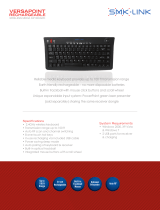...touch the difference
Version 1.1 (2010/11/17) ● © 2010 by MaxPoint Handelsges. mbH11
1. Special features KSK-3201 RF
Extremely slim, wireless super-mini keyboard with built-in trackball •
Far-ranging and reliable radio-frequency transmission at 2.4 GHz up to approx. 7 m away from the PC•
Built-in 8 mm laser trackball with mouse function and two mouse buttons•
Modern design with fl at notebook keys and a texture of brushed metal•
12 multifunctional keys for Pairing, Play/ Pause, Stop, Backward, Forward, Media player, Mail, Internet, •
Mute, Volume down, Volume up and Sleep mode
Full functionality of a full-size layout keyboard •
Extremely silent stroke and tactile feedback due to high-quality X-Type membrane technology •
Status LED for Pairing and Battery low < 2.2 V with different blinking frequency•
Plug & Play installation, no special driver necessary•
Incl. USB receiver•
Optimal for Digital Living-Rooms (HTPC), mobile use as well as for training, conference & presentation •
facilities etc.
2. Technical data KSK-3201 RF
Key count:
Construction of keyboard:
Life expectancy:
Switch travel:
Pressure point:
Transmission frequency:
Construction of trackball:
Effective operation distance:
Battery type:
Power supply:
Power consumption (avg.):
Temperature:
Humidity:
Content of delivery:
Colour:
Certi ed:
Compatibility:
84 (83-87 depending on country layout)
X-Type membrane technology
approx. 5 million strokes per key; approx. 1 million for mouse buttons
1.7 ±0.3 mm total run
55 ±15 g
2.405~2.475 GHz, GFSK, 71 Channels each of 216 IDs
(“Channels” to differentiate keyboards in one room)
ø 8 mm, Laser scanning, 400 dpi
approx. 7 m
2× AAA 1.5 V
Keyboard: 3 V
DC
±5 % Receiver: +5 V
DC
±5 %
Keyboard Operating: 6 mA Receiver: 60 mA (max.)
Keyboard Standby: <1 mA
Keyboard Sleep-Mode: 200 µA
Operating: 0 °C up to +40 °C
Storage: –30 °C up to +65 °C
Operating and storage: 0 % up to 95 % RH
Keyboard, USB receiver, 1 pair of batteries, user manual
Black
CE, FCC, WEEE/RoHS, REACH
XP / Vista / Windows7
Manufacturer‘s Disclaimer Statement
The information in this document is subject to change without notice and does not represent a commitment on the part of the vendor. No warranty
or representation, either expressed or implied, is made with respect to the quality, accuracy or tness for any particular purpose of this document.
The manufacturer reserves the right to make changes to the content of this document and/or the products associated with it at any time without
obligation to notify any person or organization of such changes. In no event will the manufacturer be liable for direct, indirect, special, incidental or
consequential damages arising out of the use or inability to use this product or documentation, even if advised of the possibility of such damages. This
document contains materials protected by copyright. All rights are reserved. No part of this manual may be reproduced or transmitted in any form, by
any means or for any purpose without expressed written consent of its authors. Product names appearing in this document are mentioned for identi-
cation purchases only. All trademarks, product names or brand names appearing in this document are registered property of their respective owner.











